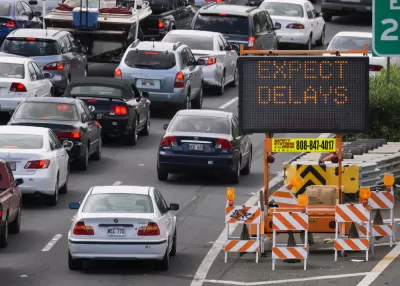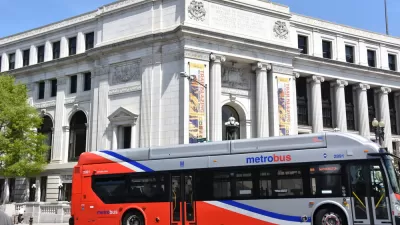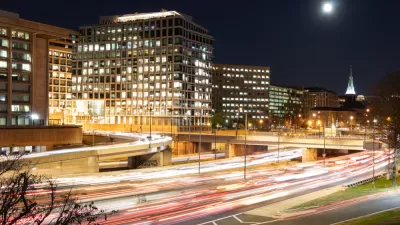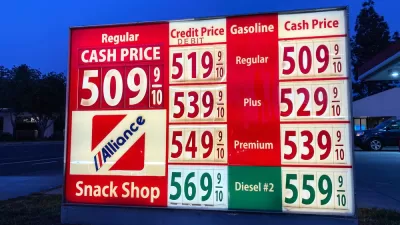With transit systems still far below historic levels, and congestion not budging, the worst effects of an automobile dependent nation fall on the environment and low-income households.

One of the big questions of the early pandemic was about the future of transportation systems: Would transit riders ever find a bus or train commute safe again? Would congestion disappear forever or come back worse than ever?
During the height of stay-at-home orders—weeks of empty streets and reports of urban dwellers fleeing forever for suburban and rural locations—it might have seemed like a future without congestion was possible.
Now, two-plus years after the beginning of the pandemic, transit ridership is still down from pre-pandemic levels and congestion is still the order of the day for most American commuters. The choices of hundreds of millions of commuters have far-reaching consequences, social, economic, and environmental, and researchers are only beginning to account for the effects of the change.
An article by Jaclene Begley, Leah Brooks, Brian J. McCabe, Jenny Schuetz, and Stan Veuger for the Brookings Institution explores the Washington, D.C. area as a case study of post-pandemic commute patterns, citing data and findings reported in the “State of the Capital Region” report recently published by the Center for Washington Area Studies and authored by the same group as the article.
Among the article’s, and the report’s, findings are that decreases job centralization is contributing to a decline of transit ridership in the region. Job centralization is a central to the performance of a “hub and spoke” transportation system. “Metrorail’s hub-and-spoke system was designed to carry workers from their suburban homes to that downtown core, as well as to supporting businesses like coffeeshops, restaurants, and bars. Tourists relied on Metrorail to access centrally located hotels, museums, and entertainment venues,” according to the article.
The report raises the point that transit ridership was declining before the arrival of Covid-19 to the United States. While the report acknowledges that the shift reflects consumer trends and preferences, there are numerous reasons why commuters should choose alternative modes:
Moving commuters in individual cars (especially sole-occupant vehicles) requires much more physical space compared to shared buses or trains. Smaller shares of transit riders mean more traffic congestion and longer commute times for everyone. The transportation sector is one of the largest contributors to greenhouse gas emissions and localized air pollution; more drivers and fewer transit riders leads to worse air quality and more negative health outcomes in the region. Owning and maintaining a car is expensive; these costs are especially onerous for low- and moderate-income households. And finally, not everyone is legally or physically able to drive; children, people with disabilities, and older adults are among the groups who are most reliant on non-car transportation.
Finally, the article notes the equity issues raised by underinvesting in public transit: the consequences of car-centric planning, automobile dependency, and poor public transit fall hardest on low-income households.
FULL STORY: Greater Washington’s commuters continue to choose gridlock

Study: Maui’s Plan to Convert Vacation Rentals to Long-Term Housing Could Cause Nearly $1 Billion Economic Loss
The plan would reduce visitor accommodation by 25,% resulting in 1,900 jobs lost.

Placekeeping: Setting a New Precedent for City Planners
How a preservation-based approach to redevelopment and urban design can prevent displacement and honor legacy communities.

Using Old Oil and Gas Wells for Green Energy Storage
Penn State researchers have found that repurposing abandoned oil and gas wells for geothermal-assisted compressed-air energy storage can boost efficiency, reduce environmental risks, and support clean energy and job transitions.

Washington State Plans Ambitious ‘Cycle Highway’ Network
The state is directing funding to close gaps in its existing bike network and make long-distance trips more accessible.

Homeowners Blame PG&E for Delays in ADU Permits
The utility says it has dramatically reduced its backlog, but applicants say they still face months-long delays for approvals for new electrical work.

Rethinking Wildfire Defense: How a Landscape Approach Can Protect Neighborhoods
Post-fire analysis of the Eaton Fire reveals that a landscape approach — including fire-resistant vegetation, home hardening, and strategic planning — can help reduce wildfire risk, challenging assumptions that trees and plants are primary fire hazards.
Urban Design for Planners 1: Software Tools
This six-course series explores essential urban design concepts using open source software and equips planners with the tools they need to participate fully in the urban design process.
Planning for Universal Design
Learn the tools for implementing Universal Design in planning regulations.
Borough of Carlisle
Caltrans
Heyer Gruel & Associates PA
Institute for Housing and Urban Development Studies (IHS)
City of Grandview
Harvard GSD Executive Education
Salt Lake City
NYU Wagner Graduate School of Public Service
City of Cambridge, Maryland





























